What to Watch for in Your Lawn

ARMYWORMS
These pests look like caterpillars. They cause brown patches that grow rapidly and can be very detrimental to Bermuda lawns in a matter of days. If you spot birds clustered on your lawn for no apparent reason, they may be at the armyworm buffet.

BROWN PATCH
Also known as large patch, brown patch appears as large, unsightly symmetrical patches that can range in diameter from a few inches to a few feet. When left untreated, the center area of a patch recovers over time, resulting in a doughnut-shaped pattern.

NUTSEDGE
Recognized by its three-sided stem and its star-like flowers, nutsedge is capable of splitting reinforced concrete and forcing its way through asphalt driveways, so it shouldn’t be taken lightly. Most common in Bermuda lawns, nutsedge is generally active between April and September.

MOSS
This weed is not the problem – it is the result of a combination of other issues including heavy clay soils, compaction, poor surface drainage, excessive shade, and possibly lack of necessary nutrients in the soil. Solutions include tactics such as soil testing to see how acidic the soil is before adding lime, pruning back trees, checking to see if the grass variety you have is the proper type for your soil and shade conditions, deeply aerating the soil to help surface drainage, and installing subsurface drainage.

DOLLAR SPOT
Named for its silver-dollar sized spots, dollar spot can spread throughout a lawn very quickly, so it’s important to treat it early for the health and appearance of your lawn.
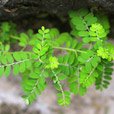
CHAMBERBITTER
Chamberbitter is a broadleaf annual that usually emerges around May or June when soil temperatures have warmed. It resembles a mimosa seedling and spreads via the seeds that form on the undersides of the branches. This weed is drought-tolerant and grows quickly. Treatment is required two to three times at 7-to-10 day intervals to get this weed under control.
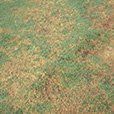
PYTHIUM BLIGHT
This devastating fungal disease can affect any type of lawn. Pythium blight first appears during hot, humid weather as small, sunken circular patches that can reach up to a foot in diameter. Leaves within the patches are matted, orange or dark gray, and greasy in appearance. As the disease progresses, the blades of grass shrivel, and the patches become light brown. This fungus requires treatments with a specific fungicide.
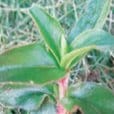
VIRGINIA BUTTONWEED
This troublesome broadleaf weed arrives with spring and continues growing throughout summer. It is a deep-rooted perennial with spreading branches that commonly thrives in moist to wet areas. It is one of the most difficult broadleaf weeds to keep in check and requires a specific treatment.

ZOYSIA PATCH
This disease attacks zoysia grass when it’s emerging from winter dormancy. Grass blades take on a tan-orange color and initially form small patches about the size of a dinner plate. These areas can quickly expand to 20 feet or more in diameter, so taking care of this disease promptly is essential for the health and appearance of your lawn.

WILD VIOLETS
Lovely when they bloom in spring, these perennials with heart-shaped leaves turn into persistent weeds during the rest of the growing season. Colonies usually start in shady spots and spread into sunnier areas. They can be controlled by digging them up, being sure to remove the entire root. For very deep or stubborn roots, sever roots with a sharp knife to remove as much root as possible. If your efforts to stop them from spreading aren’t successful, we can help.
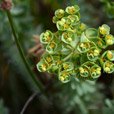
SPURGE
Spurge is a hardy, low-growing summer annual often found in turf that is thinning or newly established. Its leaves are green and up to 3/5 of an inch long with reddish-purple blotches that help to camouflage them. It flowers continuously from June through October, producing thousands of seeds. Its reddish stems, which ooze a milky white sap when broken, form a thick mat that can extend up to three feet in diameter. Two to three treatments are required at intervals of 7 to 10 days.
What to Watch for in Your Trees & Shrubs

AMBROSIA BEETLES
These pests are attracted by compromised trees, including those that are weakened, dead or dying, or have recently been cut. Once attracted to your property, they can spread to and attack freshly cut lumber and planks assembled into decks before they have dried, causing pinhole defects and dark staining in the outer wood.

JAPANESE BEETLES
Summer, while a time of blooming flowers, lush trees, and green lawns, is also the time when Japanese beetles get to work. These pests feed on more than 300 species of ornamental shrubs and trees. Their destruction causes leaves to turn brown and ultimately die and fall off.

APHIDS
Aphids thrive in spring and fall and can become a major infestation very quickly. Although they will attack any part of a tree or shrub, younger growth is especially vulnerable. These pests do their damage by sucking out fluids from leaves and stems, which weakens the plant, and by spreading viruses, which could kill some plants. To spot aphids, look for small black, white, green, or pink oval-shaped pests; they can range in size from 1/16 to 1/4 inches.
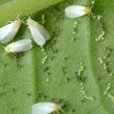
WHITEFLIES
Whiteflies thrive in warm, sunny conditions and reproduce quickly. You’ll find them on buds, stems, and the undersides of leaves, where, like aphids, they damage the tree or shrub by sucking out its fluids. A telltale sign of whiteflies is what gardeners call “plant dandruff,” a cloud of tiny white specks that emerge into the air when you rustle the leaves of a plant.

LACE BUGS
These pests are a threat to many ornamental trees and shrubs. They attack a broad range of evergreen and deciduous trees and shrubs and often go undetected until the infested plants show severe damage.

PINE BORER BEETLES
Trees and shrubs that produce cones are most susceptible to this pest. The larvae tunnel beneath the bark into the conductive tissue of the plant, interfering with sap flow and harming the cambium, a layer of tissue important for the growth of the plant. They can cause enough damage to severely stunt or even kill affected plants, often without much warning. Many pine borers also carry fungi that pose further risks to the health of cone-bearing trees and shrubs.

POWDERY MILDEW
This fungal disease appears as a gray coating with the consistency of talcum powder. It tends to attack shrubs and crepe myrtles in late spring and early summer, but you might also find it on the leaves, flowers, and even fruit of some other perennials and garden vegetables.

SCALE INSECTS
These look like tiny brown or orange blobs and can often be found near the veins on the undersides of leaves, as well as on leaf stems or in leaf joints. They produce a sticky substance as they feed, which gets onto the foliage and attracts dark sooty mold. Plants that exhibit yellowing or slow or distorted growth may have a scale insect problem.

LEAF SPOT
Leaf spot is a descriptive term encompassing a number of diseases that affect the foliage of ornamentals and shade trees. The majority of leaf spots are caused by funguses, but some are caused by bacteria. Some insects also cause damage that can be confused with a leaf spot disease due to fungi or bacteria. Leaf spots on trees are very common and generally do not require spraying. The disease may result in some defoliation, but an established plant can tolerate almost complete defoliation when it happens late in the season or when it does not occur every year. Small or newly planted trees that become defoliated are more at risk of suffering damage until they become established.
Advice for Property Owners

INSPECT YOUR PROPERTY
If you do your own landscape maintenance, it’s a good idea to do a weekly walk-around of your property. If you notice a problem between our visits, let us know right away.

RAIN
Forecasts continue to improve, but weather is still often unpredictable. Unfortunately, we must sometimes shift the times or dates of appointments to allow for successful treatments. Most of our applications need to dry on the plant—which can take only a few minutes in the spring, summer, and fall— and then be watered in. So, rain right after an application is a good thing.

SHADE
Most warm-season turfs must have wide-open space and no shade. Zoysia can be more forgiving but still needs plenty of direct sunlight, whereas Fescue is best for more shaded areas. However, the timing and duration of shade can make a difference. For example, a lawn that gets morning shade can still thrive if it gets direct afternoon sun. Six to eight hours of direct sunlight is recommended for warm-season turfs.

WATER YOUR LAWN
This is one of the most important ways that you can maintain the health and color of your lawn. We can assist you in finding a company to install a sprinkler system if you don’t have one. If you already have a system and need advice on how often to run it, we can help with that, too. Your lawn should get about one inch of water every week. Use a tuna can as a measuring tool. When you water your lawn, place the can on the area being watered. When the can is almost full, you’ve watered enough. This can make a critical difference in the color of your lawn, as well as in its resistance to disease. And if you’re wondering why we continue to treat during a drought, it’s because your lawn is a living organism that needs nutrients and weed control even when it is going through a dry period.
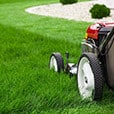
MOWING
Mowing the same day a treatment is performed is no problem as long as any application that goes on wet has dried. It’s also safe to mow after an application that goes on dry, even if you bag your clippings. While we recommend frequent mowing, we also recommend letting the clippings go back into the soil. This provides nutrients, shades the soil, and helps maintain the thatch layer.
